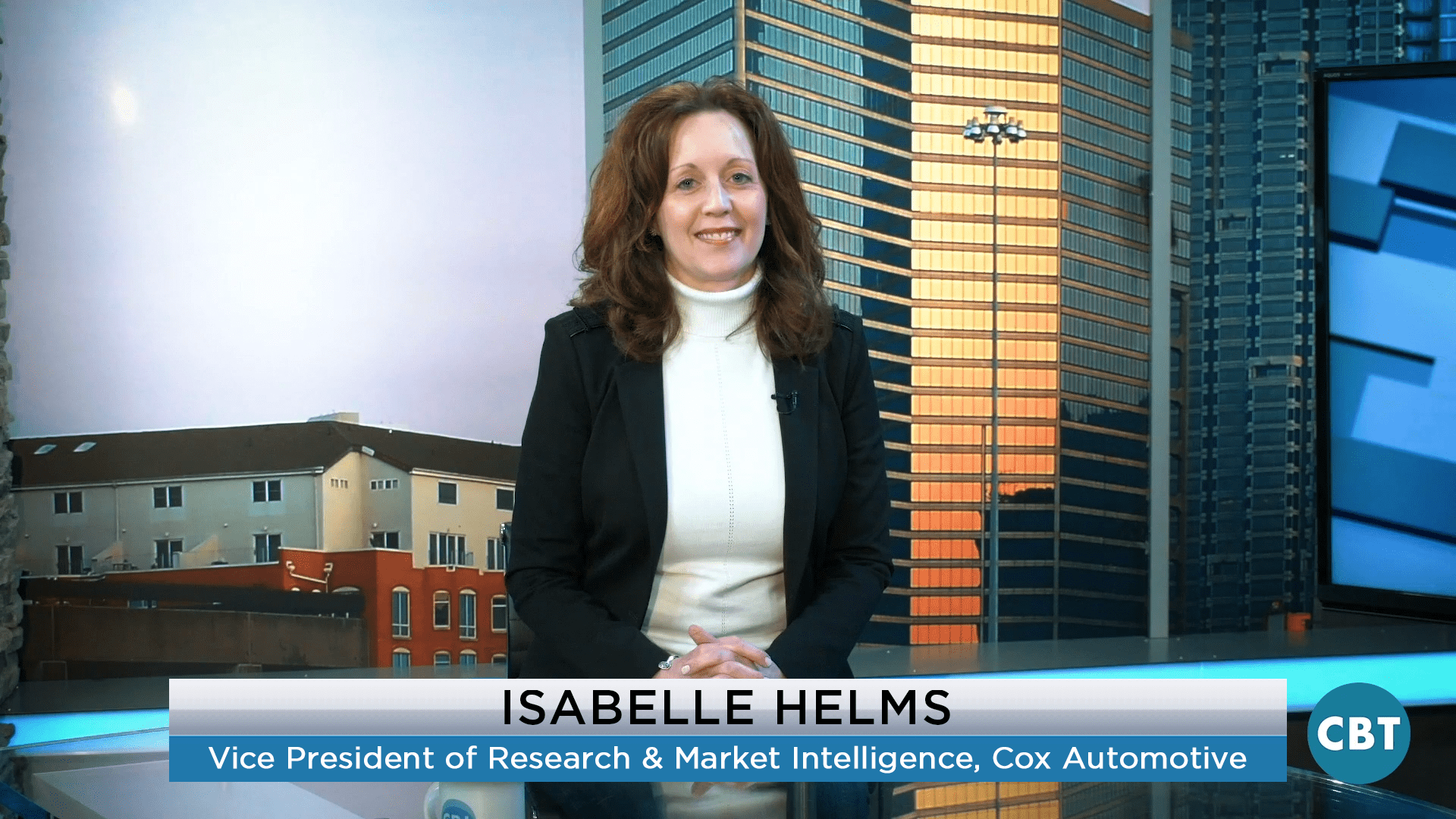As we settle into 2019, alternative vehicle ownership continues to increase in popularity with consumers. Here to guide us through this emerging market is Isabelle Helms, vice president of research and market intelligence for Cox Automotive. In today’s segment, Jim and Isabelle discuss the final chapter of the Cox Automotive Evolution of Mobility Study, and what its findings indicate about the future of retail auto sales.
To find out more about Cox Automotive’s first two stages of their Evolution of Mobility Study, click here.
VIDEO TRANSCRIPT:
Jim Fitzpatrick: Welcome to the show.
Isabella Helms: Thank you, Tim. Thank you.
Jim Fitzpatrick: That’s a mouthful there.
Isabella Helms: Yes, it is.
Jim Fitzpatrick: The Evolution of Mobility Study and the final chapter. So talk to us about the first couple of chapters.
Isabella Helms: Sure, sure. We launched this study last year to understand what is in consumer’s minds, dealer’s minds when we think about the alternatives to traditional vehicle ownership. Today, most consumers use a car to get from point A to point B. How would that change if alternatives were available to them? So in phase one, we spoke with 1200 consumers to understand the degree to which they think about these alternatives. One of the things that we learned is that the time is right for consumer disruption to occur in terms of traditional vehicle ownership.
Phase two, we spoke with dealers, over 400 dealers, to understand the degree to which they’re thinking about these alternatives and the degree to which they’re preparing themselves for this future. Key thing we learned there, which was surprising, is they’re thinking about this. They’re thinking about this seriously and they’re excited about a new revenue stream for their dealership model. The challenge they face is they don’t know how to get started because this isn’t anything they’ve done before.
So here we are phase three, which I think is the most exciting part of the mobility study. We look into the future and paint a world for consumers where all of these alternatives are available and we get a sneak peek into what happens to traditional vehicle ownership and what choices consumers end up making if these alternatives are available to them today.
Jim Fitzpatrick: Sure. So share with us some of what that looks like.
Isabella Helms: Yes, yes, for sure. One of the ways we chose to think about what the world transportation looks like today is in terms of total miles traveled. So the key thing we learned is today 93% of total miles traveled or traveled via a car that you and I own when we introduced the alternatives. And let me talk a second about what those are. When we speak about alternatives, we’re talking about ride-hailing services from Uber and Lyft. We’re talking about car sharing services from Zipcar. And then also subscription services, which is the new kid on the block where consumers will pay a monthly fee for access to a fleet of cars and that includes the cost of transfer of the car itself as well as insurance maintenance services and so on. When we make all of these alternatives available to consumers, what happens is the share of total miles traveled, drops from 93% to 72% because these alternatives all of a sudden are available for consumers.
Jim Fitzpatrick: Yeah, very cool.
Isabella Helms: So lots of interests.
Jim Fitzpatrick: What was the methodology used for the piece of research?
Isabella Helms: Sure. So without getting into research weeds that you don’t want to hear about, we chose to use a choice-based model, which is often referred to as a conjoint methodology. Simply all that is is we spoke with 2100 consumers, and we gave them 12 series of choices that they needed to make, and each series is called a card. And on each card, we presented three options. An option could be your traditional ownership model. It could be a ride-hailing solution, a subscription model. We give them a single price point, and we differentiated all of these offerings with features like is it a luxury vehicle or is it a domestic car? Is there a wait time associated with that model? Who’s driving the car? So they’re weighing all of these options and at the end of the day, they make a decision. They did that 12 times, times 2100 sure. We’re sitting on a whole lot of data that enables us to run a lot of scenarios, which is pretty cool.
Jim Fitzpatrick: Yeah, that is pretty cool. And what stood out in phase three of your study?
Isabella Helms: I think what stood out most is that when consumers told us that the cost of owning a vehicle today is just getting too expensive, four out of 10 consumers told us this, and that’s much higher than what we saw in 2015. And when you introduce these models, we see the shift in dynamic, but when the cost of these alternative models of transportation starts to decline, the proportion of miles traveled, declines even more in terms of traditional vehicle ownership. So we know today that one of the biggest barriers to adoption is availability. And again, creating this perfect world of 100% availability to all consumers creates a big shift.
Jim Fitzpatrick: I heard recently that it’s something like 4% of the amount of time that you actually use your vehicle while it’s sitting in your driveway or right in front of your office or your place of business. Is that true? Is that number accurate that you really do-
Isabella Helms: It’s a little bit higher than that. Still single digit. Lots of room for opportunity to leverage these cars more so than we are. Today, and so shared ownership is something that we believe is the model of the future.
Jim Fitzpatrick: It’s just when I heard that number, I was like, “Wow, there’re to be some alternatives then,” because of the cost of cars just rising and such and just in taking that much more of a wallet share from most households, and it just sits there, maybe 90% of the time and unused is just crazy. How will this impact retail auto sales in the US?
Isabella Helms: So this dynamic that I explained earlier where if we create a 100% availability for these alternatives where the proportion of miles traveled drops from 93% today down to 72% it has a 6% impact on retail sales, new vehicle retail sales today. Now, that’s a pretty big dip. When you start toying with prices of these alternatives, it can drop down to 29%. Key thing here that I want to make sure everyone understands is this is an extreme scenario. You have to create a 100% availability and consumers need to be aware of that. The other thing that is also important to point out is while retail sales drop, what will happen too is fleet sales will go up. Because shared transportation means if someone else has got to own the cars.
Jim Fitzpatrick: Yeah, that’s right. I didn’t think about that. Yeah. So it’s not entirely terrible news for car dealers. It’s actually good news for car dealers, right?
Isabella Helms: It’s just who owns the car will shift in the future, for sure.
Jim Fitzpatrick: And that might include dealers. What are some of the other takeaways from the site?
Isabella Helms: I think one of the other key takeaway to pay attention to is and this probably won’t surprise most people, but the first generations to jump on this alternative bandwagon, if that’s what we want to say, is millennials and Gen Z. They’re the ones today that are most impacted by the rising cost of traditional ownership. And when presented these models and these alternatives their interest is greater than the other generations.
Jim Fitzpatrick: Right, Yeah, that makes sense. Right?
Isabella Helms: Yes, of course, it makes sense. The last one that I’ll leave you with is when we look at all of the alternatives, the one that seems to have the most reception from consumers is your subscription model. Today, when you consider all miles traveled, subscription accounts for .2% of that. You create widespread availability and it jumps to nearly 10% in total miles traveled.
Jim Fitzpatrick: No kidding. Really?
Isabella Helms: So lots of opportunities for subscriptions.
Jim Fitzpatrick: So dealers really need to pay close attention to this subscription program because it’s here and it’s only going to be bigger, right? I mean as we sit here 10 years from now, are there any forecasts being made as to how many vehicles will be subscription on the road?
Isabella Helms: We don’t have a forecast yet, but we have a great model that enables us to toy around with pricing and a lot of it depends on pricing. We know that new subscription models with lower price points will be entering the marketplace really soon.
Jim Fitzpatrick: It’s pretty cool. Dealers need to jump on board now though so that they can adapt and then be there when the real market is there. Right?
Isabella Helms: Absolutely, and there are plenty of players in the marketplace, Cox Automotive being one of them that can help them transition to this new world.
Jim Fitzpatrick: Isabelle Helms with Cox Mobility. Thank you so much for joining us on CBT. We very much appreciate it.
Isabella Helms: Thank you. Thanks for your time.
Jim Fitzpatrick: Sure.
CBT automotive Network. The number one most watched network in retail automotive. CBT is a part of the JBF Business Media family.








